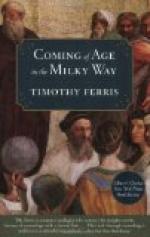|
This section contains 1,352 words (approx. 4 pages at 400 words per page) |

|
Chapters 9 and 10 Summary and Analysis
In Chapter 9, the author discusses how there were two schools of thought about elliptical nebulae. One was the theory of the "island universe" of Kant and Lambert. The other theory was the "nebular hypothesis" which theorized that the spiral and elliptical nebulae were clouds of gas that were forming new stars. As it turned out, both were correct. It was astronomer William Parsons who discovered that some nebulae had spiral structures. The photographs taken by Isaac Roberts in England in the 1880s proved that most were spirals. James Keeler estimated that the existence of over one hundred thousand such spiral nebulae was possible.
A combination of the telescope, the camera and the spectroscope would ultimately reveal the composition of the stars. Joseph Fraunhofer elevated spectroscopy to an exact science. A spectroscope, fitted with a prism, broke up the light...
(read more from the Chapters 9 and 10 Summary)
|
This section contains 1,352 words (approx. 4 pages at 400 words per page) |

|




